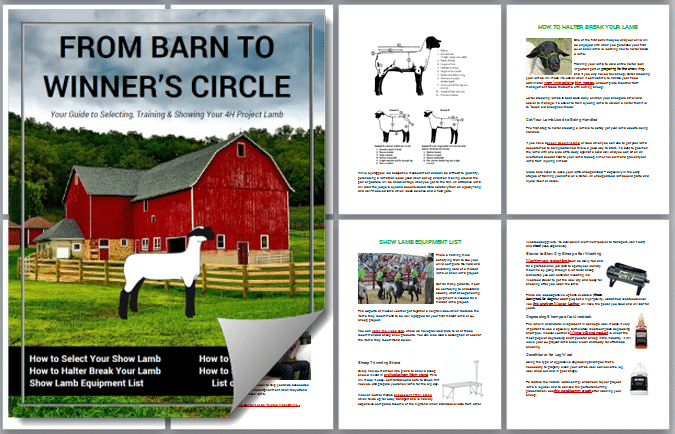As you prepare for your 4H or FFA market lamb or show lamb project, one of the first things you will need to do is to select and buy a lamb for your project. Careful consideration should be devoted to this step in the project, as the size, frame and genetics of your lamb will all play a role in how well your lamb will grow and perform under your care. In this article I’ll provide tips and information to help you purchase the ideal market lamb.
I will cover:
- Basic considerations you should make before visiting a farm to select your show lamb,
- The 4 major criteria you should use to evaluate and choose the best market lamb, and
- A brief overview of the best market lamb breeds.
Get Your FREE 4-H Lamb Guide
From Barn to Winner’s Circle is a 30-page PDF packed with our best tips to take you from buying your first lamb to placing at the top of your showmanship class.
Things to Consider Prior to Buying Your Show Lamb
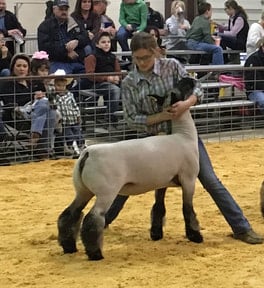
There are four things I recommend considering prior to visiting a farm to purchase your show lamb. These are:
- Breeder Reputation – Is the person you’re buying from an honest, trustworthy person who will sell you or your child a healthy lamb at a fair price? Will they stand behind the sale and be available to answer questions, guide and support you as you embark on your first market lamb project?
- Lamb Size – The frame and size of your lamb when you purchase it will be used to predict how large your lamb will be at the time of the fair. Most market lambs finish at 105-130 pounds and lambs will typically gain between 0.5-0.75 pounds per day. Larger framed lambs with superior genetics may grow faster and smaller framed lambs may grow slower. When you buy a lamb you should know when you want the lamb to reach its 105-130 pound weight range and be prepared to do some math based on the size and skeletal frame of the lambs you’re choosing from to select a lamb that will be well suited to your 4H project schedule.
- Sex of the Lamb – A ewe lamb will typically be more expensive than wether lambs (castrated rams), so if you do not have plans to keep and breed your show lamb, selecting a wether lamb for your first market lamb project may be a better choice.
- Age of the Lamb – Even the fastest growing lambs will need to be at least two months of age at fair time, so you should keep this in mind when selecting your 4H project lamb.
Considerations When Buying a Lamb at the Farm or Auction
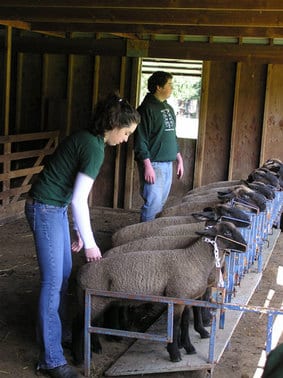
When you visit a producer’s farm to select your show lamb for purchase it’s easy to feel overwhelmed. There might be a large pen full of similar-looking lambs, and you might feel pressured to choose one before you’re ready.
Take your time. If possible, narrow the group down by your pre-determined selection criteria to begin with (wether lambs in a specific weight and age range), and pull those lambs into a smaller pen, or a rack if possible.
Some of the major features you should base your buying decision on when choosing a show lamb for your 4H or FFA project are:
- Structural Soundness
- Muscling
- Growth Traits
- Eye Appeal
Let’s take a closer look at each of these so you can go to the farm with a firm grasp on what you’re looking for.
Market Lamb Structural Soundness
Begin by removing all lambs that are not structurally sound from consideration. Lambs that have unsound feet and legs, or have a severe underbite, crossbite or overbite may not gain weight well or thrive on grain, hay and pasture, and should not be considered for your show lamb project.
These images illustrate the ideal market lamb conformation, as well as some common structural defects which you may identify when buying your first lamb.
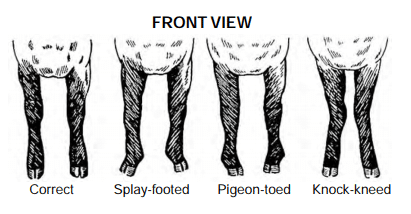
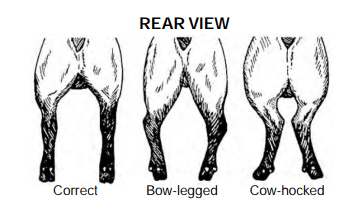
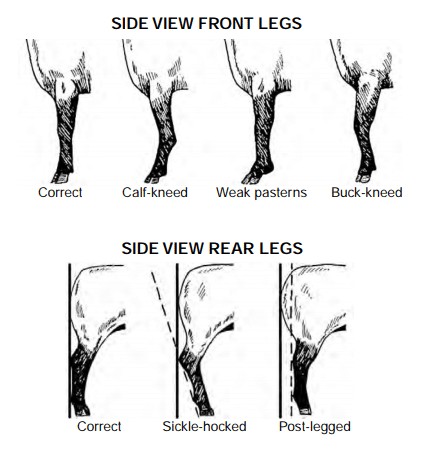
Look for nice straight legs when viewing the lamb from the front or rear. The lamb’s pasterns should be as straight as possible (the base of the hoof to the “wrist” area at the base of their legs should be as close to vertical as possible), and the rear legs should have a natural curvature to the hock (see middle image above – avoid post-legged or sickle-hocked lambs).
The lamb’s jaw should seat straight, and its teeth should line up naturally with its top gum (lambs do not have top teeth in the front of their mouth).
Market Lamb Muscling & Hip Structure
After narrowing the group based on structural soundness, evaluate the lamb’s length, muscling, and hip structure. The most expensive cuts of lamb are in the rear portion of its body (behind the last rib), so when you are selecting a market lamb you should pay careful attention to how the lamb’s rear end is structured.
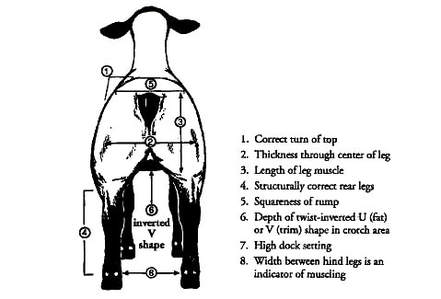
Handle each lamb and compare the length of their body from their last rib to their hip, and from the last rib to their dock. In general, the longer the lamb is, the better, but equal weight should be paid to muscling down the lamb’s topline (it should be firm and consistent in width), and over the dock (the lamb should remain thick and carry out evenly through the hips). The width of the loin (from the last rib to the hip) should also be considered, in addition to the length of the lamb’s loin. Finally, the lamb should exhibit good muscling in the rear leg.
When you continue evaluating the lamb, you should view the lamb’s hip placement on the move as well as when it is set up. Make sure that the lamb is fairly straight in the hip. If it is too straight, then move on to another lamb.
Choose a lamb that has an angular shape coming out of the shoulders towards the hindsaddle. The lamb should have an overall triangular shape. A raised edge on the outer edges of the loin is desirable.
Evaluating Market Lamb Growth Traits
When evaluating a market lamb’s growth traits, ask the producer you’re buying from if he has data about how quickly the lamb has gained weight. Most sheep farmers keep track of 30, 60, and 90 or 120 day weights on all of their lambs which will tell you how much weight the lamb has been gaining per day throughout its life. This can give you a good sense for when it will reach its finished weight, and whether that lamb’s growth schedule will align with when you will exhibit your market or club lamb.
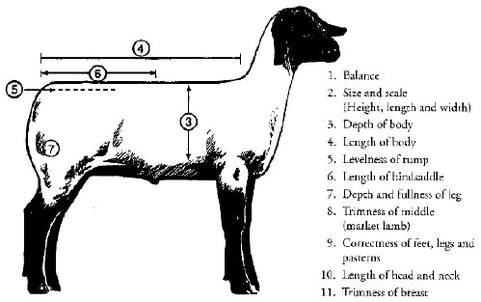
Additional things to consider are the bone structure of the lamb. Long, tall, heavy-boned lambs with a large skeletal system tend to grow faster, but may fill out and reach an ideal market lamb finished weight slower than a small, trim well balanced lamb.
Lambs whoa re bred from a high-end club lamb producer whose flock has superior genetics will follow a different growth pattern than lambs bought from a hobby farm.
Selecting for Eye Appeal when Buying a Show Lamb
While eye-appeal is a subjective measurement and can be difficult to quantify, purchasing a lamb that looks good when set up and when moving around the pen or pasture will be an advantage when you get to the fair. An attractive lamb will draw the judge’s eye and be considered more carefully than an equally-long and well-muscled lamb which lacks balance and a fluid gate.
The lamb’s front end is where it will gain or lose points for eye appeal and flashiness in the show ring. The lamb’s neck should be nice and long and blend smoothly into the shoulder. Look for a lamb whose shoulder is slightly higher than its rump, which will give you a lamb which is straight lined, balanced, and flat topped when in the show ring.
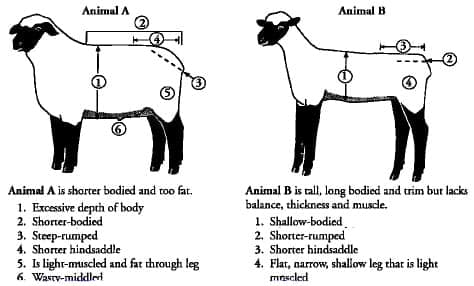
Try to avoid choosing a lamb with a bulky front end, as these lambs will look unbalanced and heavy in the show ring. In a well-balanced lamb the rack (rib cage), loin, and rump should each make up about 1/3 of the lamb’s body length.
Best Market Lamb Breeds
There’s no single “best” breed of sheep for a market lamb project. In general, you want your lamb to be a meat breed that has been developed specifically for its rate of growth and carcass quality.
In the United States, most market lambs or club lambs are crossbred or purebred lambs of Hampshire, Suffolk and Southdown genetics.
How to Buy a Lamb for Your 4H or FFA Project
Buying lambs for a 4H, FFA, or show lamb project can be overwhelming, especially if you have never bought a sheep before and you have many lambs to choose from when you arrive at the farm or auction. If you keep these ideal market lamb selection tips in mind and methodically narrow your choices you will select an excellent show lamb for your first market lamb project.
Good luck! While you’re here, please consider these other resources as you begin preparing to show your market lamb:


